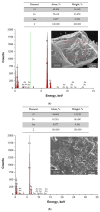The Synthesis Methodology and Characterization of Nanogold-Coated Fe3O4 Magnetic Nanoparticles
- PMID: 35591718
- PMCID: PMC9105358
- DOI: 10.3390/ma15093383
The Synthesis Methodology and Characterization of Nanogold-Coated Fe3O4 Magnetic Nanoparticles
Abstract
Core-shell nanostructures are widely used in many fields, including medicine and the related areas. An example of such structures are nanogold-shelled Fe3O4 magnetic nanoparticles. Systems consisting of a magnetic core and a shell made from nanogold show unique optical and magnetic properties. Thus, it is essential to develop the methodology of their preparation. Here, we report the synthesis methodology of Fe3O4@Au developed so as to limit their agglomeration and increase their stability. For this purpose, the impact of the reaction environment was verified. The properties of the particles were characterized via UV-Vis spectrophotometry, dynamic light scattering (DLS), X-ray diffraction (XRD), and Scanning Electron Microscopy-Energy Dispersive X-ray analysis (SEM-EDS technique). Moreover, biological investigations, including determining the cytotoxicity of the particles towards murine fibroblasts and the pro-inflammatory activity were also performed. It was demonstrated that the application of an oil and water reaction environment leads to the preparation of the particles with lower polydispersity, whose agglomerates' disintegration is 24 times faster than the disintegration of nanoparticle agglomerates formed as a result of the reaction performed in a water environment. Importantly, developed Fe3O4@Au nanoparticles showed no pro-inflammatory activity regardless of their concentration and the reaction environment applied during their synthesis and the viability of cell lines incubated for 24 h with the particle suspensions was at least 92.88%. Thus, the developed synthesis methodology of the particles as well as performed investigations confirmed a great application potential of developed materials for biomedical purposes.
Keywords: Arabic gum; core-shell nanostructures; gold nanoparticles; magnetic nanoparticles; nanoparticles agglomeration; pro-inflammatory activity; sonication-assisted agglomerates disintegration.
Conflict of interest statement
The authors declare no conflict of interest.
Figures
















References
-
- Acidereli H., Karataş Y., Burhan H., Gülcan M., Şen F. Magnetic nanoparticles. In: Sabu T., Balakrishnan P., editors. Nanoscale Processing. Elsevier; Amsterdam, The Netherlands: 2021. pp. 197–236.
-
- Samrot A.V., Sahithya C.S., Selvarani J., Purayil S.K., Ponnaiah P. A review on synthesis, characterization and potential biological applications of superparamagnetic iron oxide nanoparticles. CRGSC. 2021;4:100042. doi: 10.1016/j.crgsc.2020.100042. - DOI
Grants and funding
LinkOut - more resources
Full Text Sources
Molecular Biology Databases

